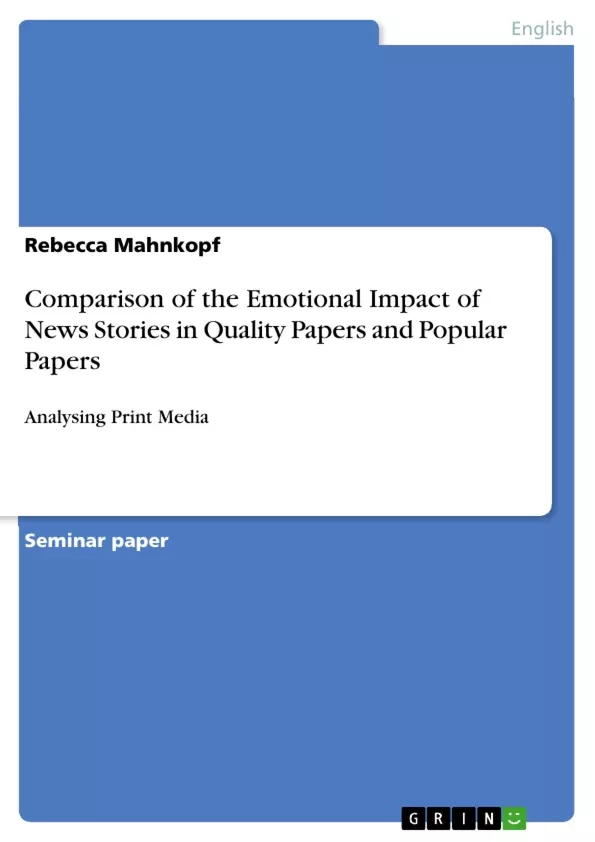Many articles one reads in a newspaper have an emotional impact on the addressee. This impact can involve the public in general or only a limited part of the readership. For instance a headline like One of these players will be axed (from News of the World, September 4, 2005) will probably not effect the whole British readership but only a part of it, namely those who are interested in soccer. They might be sad that players of their favourite team will be dismissed.
(Ungerer in Niemeyer/Dirven 1995: 307)
But how is it possible for a news story to cause emotions in the reader? In my term paper I am going to describe the system which is responsible for the emotional impact of news stories. Afterwards I will go on to give a short overview of the different kinds of emotions which can be evoked. My next section will take us to the main concern of this paper: the comparison of quality and popular papers regarding their emotional impact. I will analyse a news story from The Guardian which is one of the British quality papers. Then I will have a detailed look at a news story from the British popular paper News of the World which deals with the same issue. I will try to find out which of both the papers arouses more or greater emotions in the reader and what means they use to achieve that. What are the different ways in which emotions are approached in the two kinds of newspapers?
In my conclusion I will evaluate the comparison and make an effort to answer the question asked before.
Inhaltsverzeichnis (Table of Contents)
- Introduction: The emotional language in news stories
- Overview of news values
- The principles of inferencing
- The principle of proximity
- The principle of animacy
- The principle of rank and number
- The principle of emotion-related evaluation
- The principle of intensity of presentation
- The principle of emotional content
- Basic, secondary and norm-related emotions
- Emotional language in quality and popular papers in comparison
- Quality paper: Interpretation of a news story from The Guardian
- Popular paper: Interpretation of a news story from News of the World
- Conclusion: Evaluation of the comparison
Zielsetzung und Themenschwerpunkte (Objectives and Key Themes)
This paper examines the emotional impact of news stories in both quality and popular newspapers. It aims to analyze the system responsible for evoking emotions in readers and to compare how quality and popular papers utilize different language techniques to achieve emotional engagement.
- Emotional language in news stories
- News values and their emotional relevance
- Principles of inferencing used to trigger emotional responses
- Comparison of emotional language in quality and popular papers
- Evaluation of the comparison and analysis of emotional impact
Zusammenfassung der Kapitel (Chapter Summaries)
The introduction establishes the focus of the paper, exploring how news stories impact readers emotionally. It delves into the mechanisms responsible for this impact, highlighting how different types of emotions can be evoked.
The next section provides an overview of news values, particularly focusing on those relevant to emotional engagement. It explains how these values, such as proximity and reference to the negative, influence the likelihood of an event being reported and the emotional impact it might have on readers.
The paper then explores the principles of inferencing, outlining various linguistic strategies used in news stories to evoke specific emotional responses. This section explains how these strategies, such as the use of personal pronouns and locative adverbs, create a sense of proximity or animacy, ultimately influencing the reader's emotional engagement.
Schlüsselwörter (Keywords)
This paper examines the emotional impact of news stories, particularly focusing on news values, principles of inferencing, emotional language, and comparative analysis of quality and popular papers.
- Citar trabajo
- Rebecca Mahnkopf (Autor), 2005, Comparison of the Emotional Impact of News Stories in Quality Papers and Popular Papers, Múnich, GRIN Verlag, https://www.grin.com/document/189407



